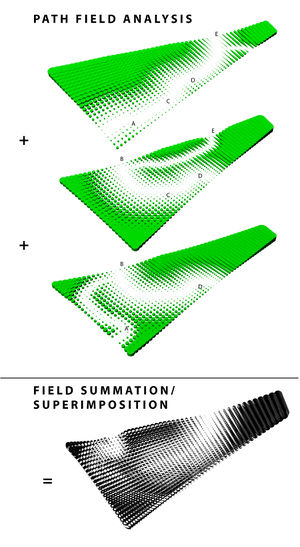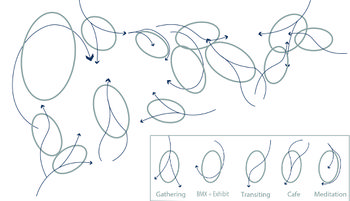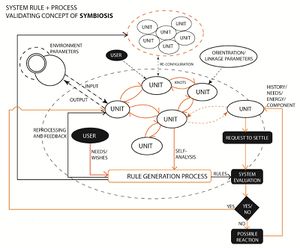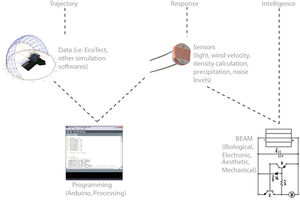atom08:NEW SITE
ISSUES
 It seems logical to consider the future requirements of the site as part of its existing context. With the global population set to exceed 7 billion this year, there will be increasing pressure on the current housing stock. A strategy must be created to adapt the urban infrastructure as a pre-requisite for future housing development. In this way, the intervention should consider how to precipitate the future scenario by beginning to implement its possible requirements.
It seems logical to consider the future requirements of the site as part of its existing context. With the global population set to exceed 7 billion this year, there will be increasing pressure on the current housing stock. A strategy must be created to adapt the urban infrastructure as a pre-requisite for future housing development. In this way, the intervention should consider how to precipitate the future scenario by beginning to implement its possible requirements.
CLIENTS
It seems logical to consider the future requirements of the site as part of its existing context. With the global population set to exceed 7 billion this year, there will be increasing pressure on the current housing stock. A strategy must be created to adapt the urban infrastructure as a pre-requisite for future housing development. In this way, the intervention should consider how to precipitate the future scenario by beginning to implement its possible requirements.
CHALLENGES
 It seems logical to consider the future requirements of the site as part of its existing context. With the global population set to exceed 7 billion this year, there will be increasing pressure on the current housing stock. A strategy must be created to adapt the urban infrastructure as a pre-requisite for future housing development. In this way, the intervention should consider how to precipitate the future scenario by beginning to implement its possible requirements.
It seems logical to consider the future requirements of the site as part of its existing context. With the global population set to exceed 7 billion this year, there will be increasing pressure on the current housing stock. A strategy must be created to adapt the urban infrastructure as a pre-requisite for future housing development. In this way, the intervention should consider how to precipitate the future scenario by beginning to implement its possible requirements.
SITE LEVEL ANALYSIS
SITE USERS
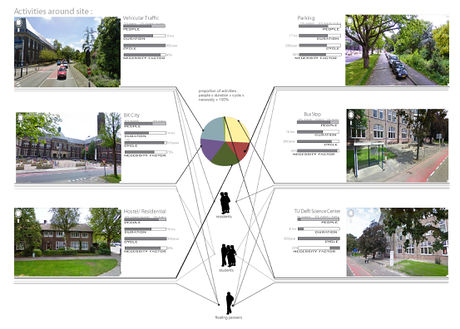 Activities around the site are monitored to extract the different user groups and usage parameters. Like, which user group performs which activity and to what extent. The activity duration hours per day, the activity cycle around the year and the necessity factor regarding to that specific activity and user group. These parameters when compiled in terms of proportion, gives an approximate user activity dependency statistics in and around the site limits.
Activities around the site are monitored to extract the different user groups and usage parameters. Like, which user group performs which activity and to what extent. The activity duration hours per day, the activity cycle around the year and the necessity factor regarding to that specific activity and user group. These parameters when compiled in terms of proportion, gives an approximate user activity dependency statistics in and around the site limits.
USERS' DEMANDS
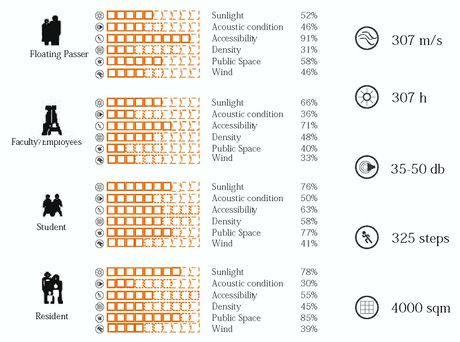 Site is inhabited by four types of user groups, namely Residential, Students, Floating passers-by and TU Delft employees; each of the classification has different life habits and needs/expectations.
Site is inhabited by four types of user groups, namely Residential, Students, Floating passers-by and TU Delft employees; each of the classification has different life habits and needs/expectations.
Inter-Connections
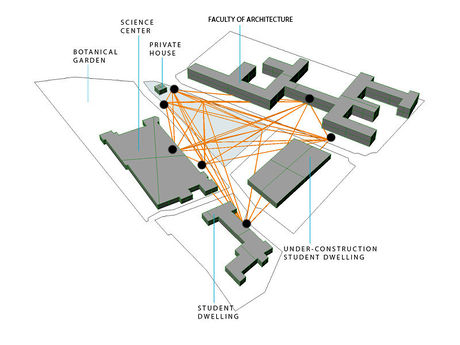 Here various functions taking place around the site are interconnected to one another giving rise to the conflict or intersection points in and around the site. This gives a rough idea about the overall dependency scenario.
Here various functions taking place around the site are interconnected to one another giving rise to the conflict or intersection points in and around the site. This gives a rough idea about the overall dependency scenario.
CONTEXT EVALUATION
SYMBIOSIS
 It seems logical to consider the future requirements of the site as part of its existing context. With the global population set to exceed 7 billion this year, there will be increasing pressure on the current housing stock. A strategy must be created to adapt the urban infrastructure as a pre-requisite for future housing development. In this way, the intervention should consider how to precipitate the future scenario by beginning to implement its possible requirements.
It seems logical to consider the future requirements of the site as part of its existing context. With the global population set to exceed 7 billion this year, there will be increasing pressure on the current housing stock. A strategy must be created to adapt the urban infrastructure as a pre-requisite for future housing development. In this way, the intervention should consider how to precipitate the future scenario by beginning to implement its possible requirements.
LINKAGES
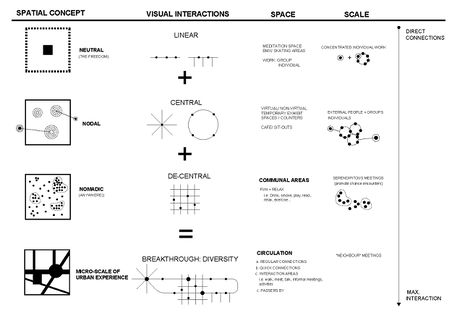 The site at present lies dormant, with majority of activities taking place around it. Here what is majorly missing is the concept of spatial and visual interaction among user groups and functions. Spaces can further be intensified into Neutral, Nodal and Nomadic in nature. Each of these have their own visual interaction qualities. The main aim is to combine all of these into a space providing a urban-like experience with maximum interaction levels
The site at present lies dormant, with majority of activities taking place around it. Here what is majorly missing is the concept of spatial and visual interaction among user groups and functions. Spaces can further be intensified into Neutral, Nodal and Nomadic in nature. Each of these have their own visual interaction qualities. The main aim is to combine all of these into a space providing a urban-like experience with maximum interaction levels
BRIEF
This project indicates a dynamic way of expanding from a flat surface into a fabricated system. The whole system shows different situations of density, which forms various spaces inside and outside. This dynamic system includes, components, skins and structures, and illustrates a smooth change in the fabrication of architecture. Users would treat this not only as constructed object but also as an integral enhancement of the site. Our concept "Symbiosis" in a way reflects this very phenomenon.
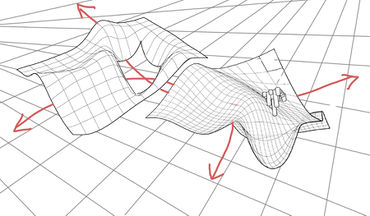 This project begins with an investigation into topological surfaces, different modules will be developed that could function both as surface and structure. The developed modules will allow for numerous connection combinations which enables behavioral characteristics within the system including, bending, torquing, flipping, splitting, and lifting by alternating component connections/ units and scale in order to adapt to various site parameters like user density, sun, wind, precipitation and noise. At some parts components morph into flat panels which merge with the ground. This will allow the system to act both as floor, wall, and roof, while blurring the lines between these conditions.
This project begins with an investigation into topological surfaces, different modules will be developed that could function both as surface and structure. The developed modules will allow for numerous connection combinations which enables behavioral characteristics within the system including, bending, torquing, flipping, splitting, and lifting by alternating component connections/ units and scale in order to adapt to various site parameters like user density, sun, wind, precipitation and noise. At some parts components morph into flat panels which merge with the ground. This will allow the system to act both as floor, wall, and roof, while blurring the lines between these conditions.
INTERVENTION
Our intervention will be a path through the park linking different uses. These uses will be walking, cycling, skateboarding, lounge area’s indoors and outdoors. This path will be a three-dimensional spatial structure that is shaped/molded/wrapped/warped according to the use. The structure will be interactive with its environment and its users. The primary task of such a structure as providing a sense of semi-enclosed space for people, alone or in groups, to feel comfortable while sitting, eating, transiting, conversing and/or reading along it.
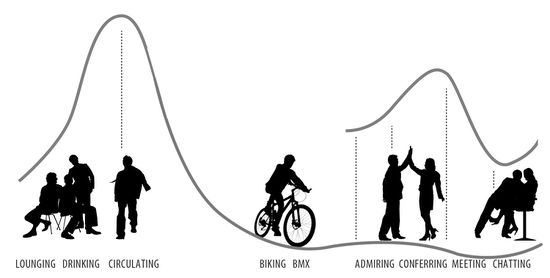 Linkages are conceived to allow for almost constant spatial experience when switching from one path to another. The user is in a state of constant arrival to the same destination repeatedly and this view is mediated and controlled by the imposed view angle of the space, enclosure, openings and speed of motion. While performing the intervention, we need to take into account few other factors as well, like:
Linkages are conceived to allow for almost constant spatial experience when switching from one path to another. The user is in a state of constant arrival to the same destination repeatedly and this view is mediated and controlled by the imposed view angle of the space, enclosure, openings and speed of motion. While performing the intervention, we need to take into account few other factors as well, like:
[exploring the design, rules and functioning of a multi component system in detail]
[exploring temporal structures]
[creating a place of linkage within the urban void]
[instrument for activating the present landscape]
[material/component re-usability or extension after completion of structure's life cycle]
DESIGN SYNTHESIS
Site path circulation analysis
This field will provide us with representational particles that might be the building blocks of our structure. These representational particles might be further developed by analyzing their density to observe their transitional behavior or by linking the particles together to produce a series of parallel strands and thus construct a relationship between the generated pattern and topographic condition.
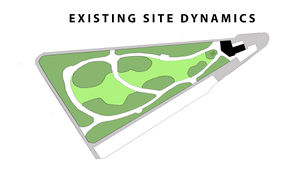
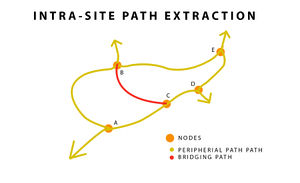
Here different possible paths through the existing site are considered as attractors and thus create a field around it. All these separate path fields are then taken and superimposed on one another to extract a differential spatial conditions depending on the varying degrees of concentration of usage and accessibility. This will help in the organization of various functions and zoning the site in the most logical way. The Circulation study is based on programmatic functions such as; Gathering Area, Café, Transit linkages, BMX, Meditation and Exhibit.
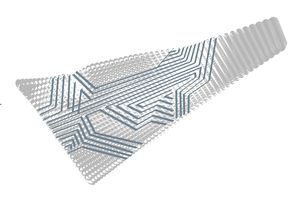
SPACE QUALITIES
Which is the appropriate position for each use/function?
Which use is placed high and which one lower?
Which use is visible and which one is hidden?
Which use can be indoor and which one outdoor? or semi-open?
Which part of the space is only for pedestrians, only for bikes-skateboards and where they can coexist?
Which functions are autonomous and which one can interact with the others?
PARTI DIAGRAMS
Circulation studies where then applied to the spatial condition which then shifts and rotate the spaces accordingly, thus giving rise to various parti diagrams. The information gathered from site analysis was used as feedback.
</div>
MULTI-COMPONENT SYSTEM RESEARCH
Patterns and Geometry
 It seems logical to consider the future requirements of the site as part of its existing context. With the global population set to exceed 7 billion this year, there will be increasing pressure on the current housing stock. A strategy must be created to adapt the urban infrastructure as a pre-requisite for future housing development. In this way, the intervention should consider how to precipitate the future scenario by beginning to implement its possible requirements.
It seems logical to consider the future requirements of the site as part of its existing context. With the global population set to exceed 7 billion this year, there will be increasing pressure on the current housing stock. A strategy must be created to adapt the urban infrastructure as a pre-requisite for future housing development. In this way, the intervention should consider how to precipitate the future scenario by beginning to implement its possible requirements.
Mapping Parameters
 It seems logical to consider the future requirements of the site as part of its existing context. With the global population set to exceed 7 billion this year, there will be increasing pressure on the current housing stock. A strategy must be created to adapt the urban infrastructure as a pre-requisite for future housing development. In this way, the intervention should consider how to precipitate the future scenario by beginning to implement its possible requirements.
It seems logical to consider the future requirements of the site as part of its existing context. With the global population set to exceed 7 billion this year, there will be increasing pressure on the current housing stock. A strategy must be created to adapt the urban infrastructure as a pre-requisite for future housing development. In this way, the intervention should consider how to precipitate the future scenario by beginning to implement its possible requirements.
FABRICATION + ADAPTATION
ITERATION
![]() Different techniques such as repetition, unfolding, bending, mirroring, twisting, scaling and duplication will be carried out on component geometry to develop construct iterations
Different techniques such as repetition, unfolding, bending, mirroring, twisting, scaling and duplication will be carried out on component geometry to develop construct iterations
SYSTEM RULES
Inorder for elements in these components to be self-organizing and reconfiguring, there have to be a set of inbuilt rules for them to arrange themselves, so that the system is not chaotic and at the same time, is not stable/static.
Rules would help to give a basis for the system to organize itself. A system must meet a number of conditions and constraints to be able to move from a disordered state to an ordered one. This could also be done by establishing a set of rules for the system. The intent is to create a system that has no organization within itself but, if provided with the right conditions, it could self-organize.
Exploring a set of rules. and how a change in one situation could affect the rest of the elements within the system. Also, how elements could self-organize themselves with just a few rules.
MATERIAL
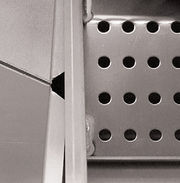
SHEET METAL: It can be folded without loss of structural integrity) can be formed into complex, three-dimensional shapes by multi-axis folding machine or CNC miller.
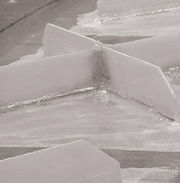
FIBRE-GLASS: As with any pouring or moulding process, the act of casting shapes out of fluid materials has the advantage that complex, curved surfaces may be achieved.
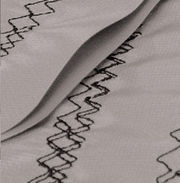
MEMBRANE FABRIC: An air cell structure is one that is self-supportable and self-erectable using only an air fan, it is constructed entirely from fabric and can therefore be reduced to a small volume for handling and transportation. Cellular nature of the structure offers an enormous range of geometrical variations including the capacity to be self-supporting and to resist wind load.
STRUCTURE
 It seems logical to consider the future requirements of the site as part of its existing context. With the global population set to exceed 7 billion this year, there will be increasing pressure on the current housing stock. A strategy must be created to adapt the urban infrastructure as a pre-requisite for future housing development. In this way, the intervention should consider how to precipitate the future scenario by beginning to implement its possible requirements.
It seems logical to consider the future requirements of the site as part of its existing context. With the global population set to exceed 7 billion this year, there will be increasing pressure on the current housing stock. A strategy must be created to adapt the urban infrastructure as a pre-requisite for future housing development. In this way, the intervention should consider how to precipitate the future scenario by beginning to implement its possible requirements.
ASSEMBLY LOGIC
 It seems logical to consider the future requirements of the site as part of its existing context. With the global population set to exceed 7 billion this year, there will be increasing pressure on the current housing stock. A strategy must be created to adapt the urban infrastructure as a pre-requisite for future housing development. In this way, the intervention should consider how to precipitate the future scenario by beginning to implement its possible requirements.
It seems logical to consider the future requirements of the site as part of its existing context. With the global population set to exceed 7 billion this year, there will be increasing pressure on the current housing stock. A strategy must be created to adapt the urban infrastructure as a pre-requisite for future housing development. In this way, the intervention should consider how to precipitate the future scenario by beginning to implement its possible requirements.
MECHANISM
 It seems logical to consider the future requirements of the site as part of its existing context. With the global population set to exceed 7 billion this year, there will be increasing pressure on the current housing stock. A strategy must be created to adapt the urban infrastructure as a pre-requisite for future housing development. In this way, the intervention should consider how to precipitate the future scenario by beginning to implement its possible requirements.
It seems logical to consider the future requirements of the site as part of its existing context. With the global population set to exceed 7 billion this year, there will be increasing pressure on the current housing stock. A strategy must be created to adapt the urban infrastructure as a pre-requisite for future housing development. In this way, the intervention should consider how to precipitate the future scenario by beginning to implement its possible requirements.
DETAILS
 It seems logical to consider the future requirements of the site as part of its existing context. With the global population set to exceed 7 billion this year, there will be increasing pressure on the current housing stock. A strategy must be created to adapt the urban infrastructure as a pre-requisite for future housing development. In this way, the intervention should consider how to precipitate the future scenario by beginning to implement its possible requirements.
It seems logical to consider the future requirements of the site as part of its existing context. With the global population set to exceed 7 billion this year, there will be increasing pressure on the current housing stock. A strategy must be created to adapt the urban infrastructure as a pre-requisite for future housing development. In this way, the intervention should consider how to precipitate the future scenario by beginning to implement its possible requirements.
AUTOMATION
How much intelligence is efficient to embed
In order to understand which electronics and software would be best suited to our needs it is important to understand the different impacts that they could have on the user interface and resulting fabrication. There is a gradient of intelligence that can be embedded including an integration of more than one system approach.
BEAM(Biological, Electronic,Aesthetic, Mechanical)approach will be adopted in this regard.
BEAM
Design of the component makes it inherently reactive to its environment. It is therefore possible to embed an intelligence into the component; an ability to respond to external conditions independently. It is conceivable to employ this technology in the focusing system associated with the enclosures. Based on system design, the component would continuously adapt by treating the connection between circuit components as neurons in the brain.
SURVEY
We have created a online questionnaire. With the gathered information we try to improve the communication and cooperation with our validators.
VALIDATORS
STUDENTS BK: Wouter Kroon Ifigenia Dimitrakou
RESIDENTS STUDENT DWELLING: Ramon Rodrigo
ARCHITECTS:
PROFESSIONALS: Ben Bisseling (royal haskoning)
EXPERTS
FABRICATION:
SENSOR TECHNOLOGY:
PRACTICE-DESIGN OFFICE
INDUSTRIAL DESIGN
REFERENCES



